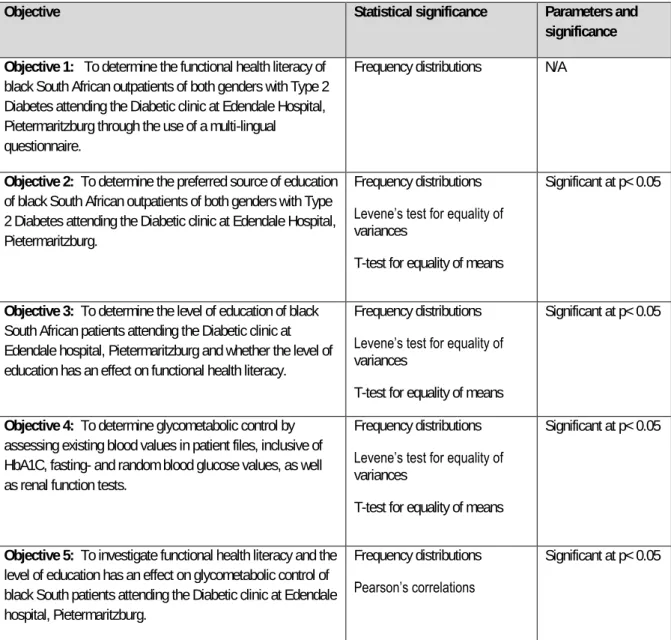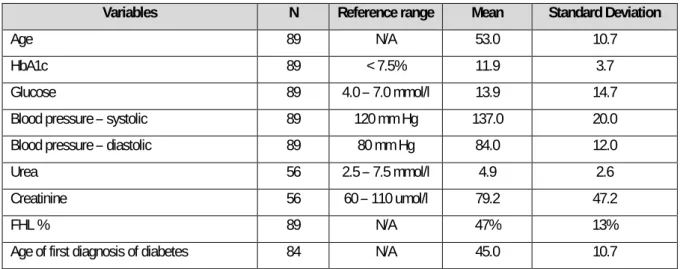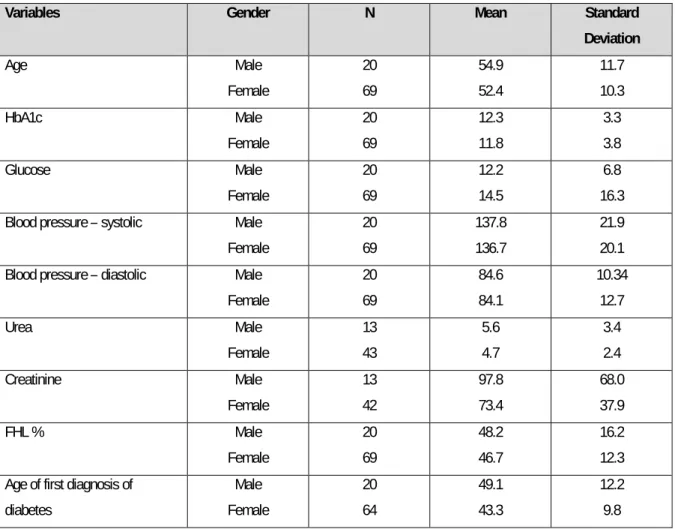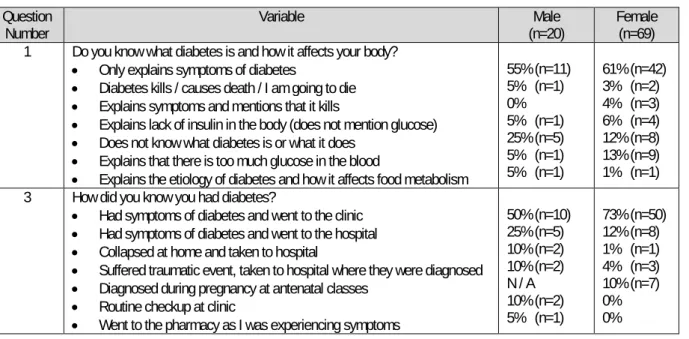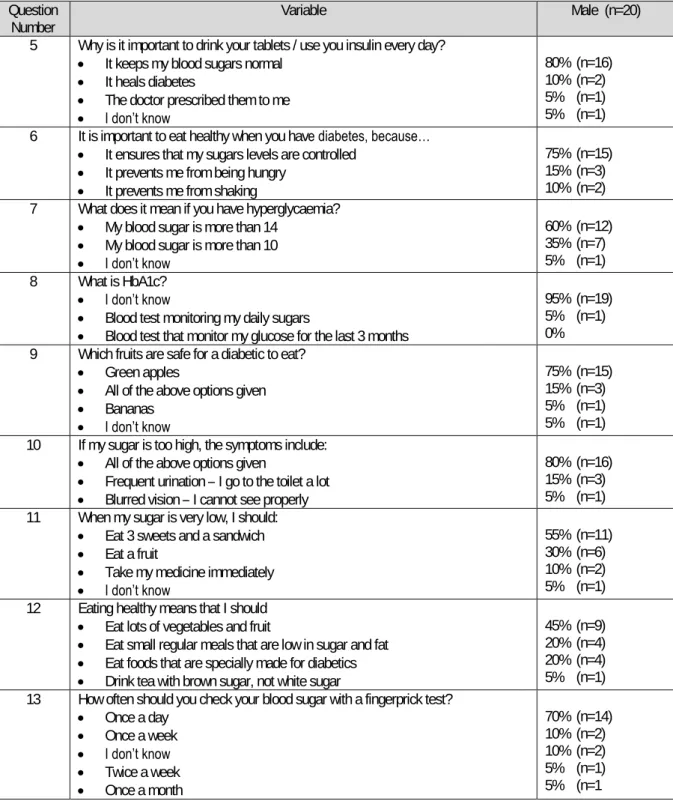A highly significant correlation was found between the highest grade obtained by participants in the study and the age of the participant (Pearson value = -0.415; p = 0.000, N=89). A significant correlation was found between participant age and their HbA1c levels (Pearson value = 0.214; p = 0.044; N = 89), which could be due to the fact that a lower FHL% is found in older patients with a lower education level.
Motivation for the study
Various questionnaires have been designed using the Short Test of Functional Health Literacy in Adults (STOFHLA) as a basic template. A study by Schillinger et al (2004) has shown that a STOFHLA questionnaire adapted to patients with type 2 diabetes was effectively used to determine the relationship between diabetic health literacy and glycemic control.
Aim of the study
Research conducted in South Africa has shown that traditional beliefs and culture also play an important role in health care decision-making and treatment adherence (Hughes, Aboyade, Clark & Puoane 2013; Mshunqane, Stewart & Rothberg 2012). It is for this reason that FHL should be tested in a group of diabetic patients from a resource-poor setting to determine the level of health literacy of these patients and what impact, if any, it has on glycemic control.
Objectives of the study
These questionnaires have been adapted for various conditions, including lifestyle diseases such as type 2 diabetes and hypertension (Schillinger, Grumbach, Piette, Wang, Osmond, Daher, Palacios, Sullivan & Bindman 2004). 3 1.3.1 To determine the functional health literacy of black South African patients of both genders with Type 2 Diabetes attending the diabetes clinic at Edendale Hospital, Pietermaritzburg through the use of a multilingual questionnaire.
Definition of terms
While type 1 diabetes is characterized by the destruction of pancreatic beta cells, resulting in a marked decrease in insulin production and secretion, type 2 diabetics exhibit cellular insulin resistance and secretory defects (SEMDSA 2012). Glycosylated hemoglobin is tested in diabetics to determine the average plasma glucose level over the past two to three months and is therefore a more accurate way to determine glycometabolic control (SEMDSA 2012).
Delimitations of the study
Because type 1 diabetes and type 2 diabetes sometimes overlap in the late teens and early twenties, it was decided that 30 years would be the youngest age considered for this study. Because newly diagnosed patients often have dysregulated blood glucose and have not yet received basic education about their condition, it was decided that all patients must have received outpatient treatment for more than three months before being included in this study.
Assumptions of the study
This three-month grace period would allow the patient's blood sugar to stabilize on treatment and receive health education offered by the outpatient clinic.
List of abbreviations
The short version of the TOFHLA (s-TOFHLA) involves only two reading comprehension sections to assess literacy (Berkman et al 2004). Functional health literacy (FHL) can be defined as the extent to which patients acquire, process and understand basic health information needed to make appropriate health decisions (Jeppesen et al 2009). Functional health literacy (FHL) can be measured using a variety of instruments, including the REALM test (using word recognition and comprehension), the s-TOFHLA (test of numeracy and word comprehension) as well as the Newest Vital Sign test (with scenario-based questions) (Tang et al 2007).
Other answer (write the answer below) Other answer (write the answer below) All of the above.

Outline of dissertation
Introduction
Prevalence of Diabetes Mellitus
The prevalence of diabetes mellitus (DM) in low- and middle-income countries is rapidly increasing due to economic development resulting in urbanization, acculturation and a change in dietary habits and lifestyle (Whiting, Guariguata, Weil & Shaw 2011). The IDF estimates that the prevalence of diabetes in Africa would increase by 109.1% by 2035, affecting an estimated 5.4 million people.
Global Health Expenditure
Mortality rates for diabetes
In order to ensure that diabetes care programs are successful and cost-effective, the level of education of the target audience and functional health literacy (FHL) must be considered. Background data of the study participants was collected and presented in Table 4.1 in its entirety. In order to ensure that diabetes self-management care programs are successful and cost-effective, the level of education of the target audience and functional health education must be considered (AADE 2011).
Applicability of the REALM health literacy test to an English-speaking South African population.
Diabetes Self-Management Education Programmes (DSME)
Socio-economic barriers to effective health care provision
Brown et al (2004) found that health care is often not sought by those from low socio-economic backgrounds, as patients feel that public health facilities do not offer support or understand the hardships they face. The Cost of Diabetes in India (CODI) study surveyed 5,516 diabetics receiving active treatment and found that those who were uneducated, unemployed, and lived in semi-urban and rural areas were more likely to develop diabetes at a later stage to be diagnosed from the onset of the disease, only after complications have already developed.
Functional Health Literacy
- Definition of Functional Health Literacy
- Assessing Functional Health Literacy
- Global studies conducted on FHL and diabetes management
- Local studies conducted on FHL
Various questionnaires have been developed by various stakeholders to assess functional health literacy (WHO 2013, citing S|rensen et al, 2012). Schilinger et al (2002) therefore recommended assessing both a patient's health literacy and knowledge about diabetes before implementing a healthcare intervention.
Conclusion
Introduction
Study design
Advantages and disadvantages of a cross-sectional descriptive study design
23 to the inherent design of a cross-sectional descriptive study, it is difficult to identify causative factors as they are only measured at one point in time. It is also difficult to make causal inferences as a study may produce different results if conducted at a different time (Levin 2006).
Sampling
Study population
Therefore, it is of utmost importance to ensure that when using this study design, questions are formulated to ensure that time is not presented as a limiting factor (Levin 2006).
Sample
Sampling technique
25 Both sexes were selected to participate in the survey to obtain a more representative sample of type 2 diabetics attending the Edendale Hospital diabetic outpatient clinic. Only two participants were excluded from the study; one withdrew from the study due to fear of identity theft and one patient had type 1 diabetes and did not meet the inclusion criteria.
Methods and Instruments
To determine the preferred source of education for black South African outpatients of both sexes with type 2 diabetes attending the diabetes clinic at Edendale Hospital, Pietermaritzburg. To investigate functional health literacy and educational attainment have an effect on glycometabolic control of black southern patients attending the diabetes clinic at Edendale hospital, Pietermaritzburg.
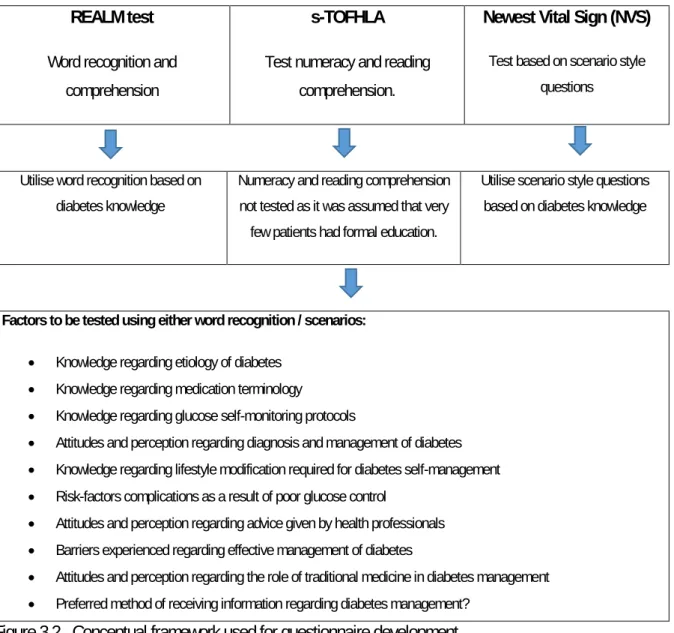
Reliability of the questionnaire
Validity of the questionnaire
Ethical consideration and consent
Ethical Consideration
Consent
Pilot study
Fieldworker recruitment and training
The field worker was also instructed not to start filling out the questionnaire without obtaining written consent. The questions asked by the field worker were discussed until he was confident that he could conduct the survey unsupervised.
Data collection
Training for fieldworkers took place in the Dietetics Department at Edendale Hospital, where the researcher asked the fieldworker to review the survey questionnaire and explain each question as he understood it. Three patients with type 2 diabetes attending the Dietetics Department for consultation were asked to participate in the fieldworker's initial training, which involved conducting the survey, while the principal investigator observed the fieldworker's approach to asking questions. the survey questions and how the concept of the survey was implemented. Several answer options were explained to the participants.
Data capturing, processing and statistical analysis
There were 33 values available on the day of the survey, but these were then retrieved from the hospital laboratory system after the interview. 34 FHL scores were determined by marking the questionnaire response on the raw data sheets while the responses were still in isiZulu.
Conclusion
Introduction
Background data of study group as a whole
Description of functional health literacy by gender
37 Table 4.4 Summary of the different pharmacological treatment regimens received by patients who volunteered to participate in the study. This is a possible indication that lifestyle measures, such as the level of knowledge and lack of understanding regarding diabetes self-management, play an important role in controlling the glycometabolic control of the participants in this study. Assessment of the level of knowledge of diabetes in patients with diabetes in primary health care.
Mortality in type 2 diabetes mellitus - size of evidence from a systematic review and meta-analysis.

Variables of study outlined by gender
FHL by gender
Almost 60% of the participants could not explain what hyperglycemia is and none of the participants could define HbA1c. Almost one-third to one-half of the participants surveyed believed that a healthy, balanced meal involved eating food that is cooked.

Preferred source of education
Title of the study: Functional health literacy and glucose regulation in African patients with type 2 diabetes mellitus attending an outpatient clinic at Edendale Hospital, Pietermartizburg. To determine the functional health literacy of patients with type 2 diabetes attending the diabetes clinic at Edendale Hospital, Pietermaritzburg.
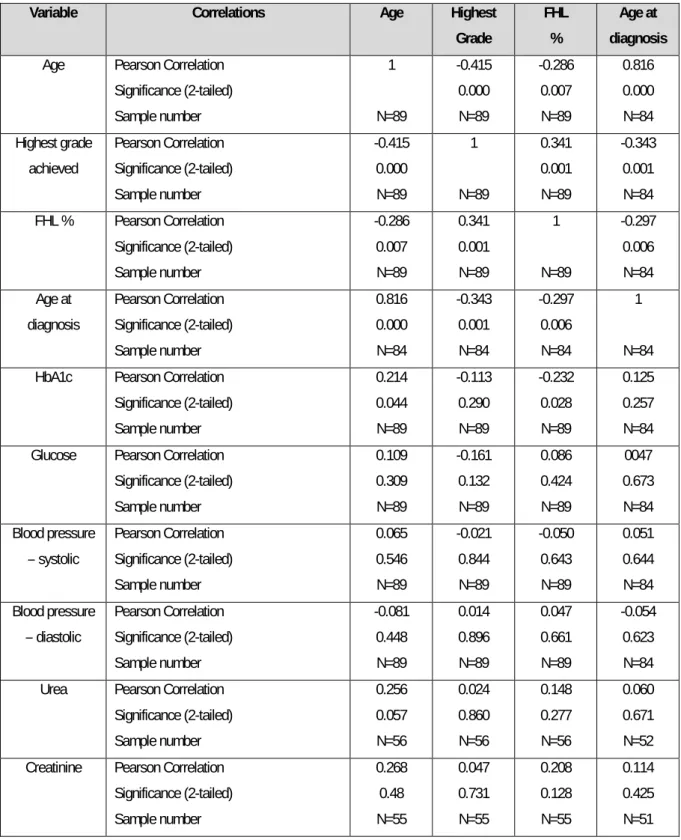
Correlation between the study group as a whole
Conclusion
Introduction
Sample Characteristics
- HbA1c and Post-prandial blood glucose levels
- Blood pressure control
- Urea and creatinine levels
- Pharmacological treatment regimens
- Highest level of education attained
- Diagnosis of diabetes and interaction with health care system
The participants in this study did not achieve glycometabolic control, with the mean HbA1c for male participants and that of female participants. This suggests that despite the necessary escalation of pharmacological treatment, glycometabolic control was not achieved in the majority of participants.
Functional Health Literacy
Significant correlations between study variables
A significant correlation was found between participant age and their HbA1c levels (Pearson value = 0.214; p = 0.044; N = 89), which may be attributed to the low proportion of FHL found in older patients with levels lower education. Although this finding is expected, it is important to note that FHL% was affected by the age of the participants and the highest grade achieved in school.
Conclusion
This ties in with the correlations between the highest degree versus the age of the participant, as participants with a higher age were less likely to have advanced schooling, which then affected FHL%. It is therefore important that any diabetes self-management education programs consider not only the literacy of the patient, but the age of participants and their level of schooling.
Introduction
Conclusion
A correlation between FHL score and the highest level of schooling (grade) achieved by male and female participants also found no significant differences at p<0.05 between genders. A highly significant correlation was found between FHL score and highest grade attained, as well as between the age at diagnosis of diabetes and the highest grade of schooling attained.
Study limitations
Recommendations for DSME and further research
Screening questions to predict limited health literacy: a cross-sectional study of patients with diabetes mellitus. The University of KwaZulu-Natal aims to determine the various factors that influence health literacy in patients with Type 2 Diabetes.
